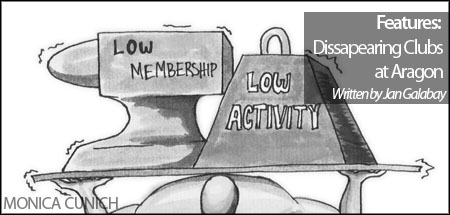
Initiating a club at Aragon requires much determination, made evident by the planning process that goes into it. Yet, while starting a club is hard, keeping it alive is even harder. With ingenuity and uniqueness, some clubs maintain their strength, while others fail to keep up.
Not all clubs gain popularity right away. Senior Katherine La Serna, also the president of All Cultures Club says, “It has been difficult trying to get new members because many people do not hear the announcements or do not look at the posters that I have in school. However, I think the biggest problem would be competing against well- established clubs since they have more money and have been running the longest.”
Other school activities deter the progress of clubs. Senior Elena Roldan, president of Fashion Club says, “Our last fashion show was especially difficult because it was in the gym. There was after school sports and the gym was constantly being used and not all of the models could be there together at one time.” A member of the Dodgeball Club, sophomore Alex Garcialuna says, “The small gym that we have been meeting in has been closed because of the construction [so the club does not exist anymore].”
Furthermore, leadership in the club is also one of the reasons that some clubs vanish. Junior Pablo Gonzalez says, “Anime Club has been running since my freshmen year and got disbanded after my sophomore year. All the people in charge of the club graduated and they forgot to assign new leaders.”
As demographics and student interests change over time, there are shifts in club popularity and membership. Polynesian Club President MalisaNaeata says, “We have not had a lot of boys in the club since before I started coming to Aragon, but this year even non-Polynesian boys participated in the Haka (Maori dance) during the homecoming rally.”
In addition, clubs that look good on college applications have a greater chance of surviving. Senior Valeria Beltran says, “I think some popular clubs like Harvard Model Congress or Key Club are more academic that they attract more students compared to clubs that are just for fun and are less productive.” Senior Hanna Koh, who joined Tutor Club adds, “I think that a club is more successful if it relates to something that students find interesting or feel like could benefit them.”
Nonetheless, because of a hectic schedule and rigorous courses, some students still prefer fun clubs. Junior and president of Environmental Impact Committee (EIC) Tammy Ng says, “Unlike other clubs, we have to do something. Our cause is not as appealing as having fun. There is a commitment involved. We have to realize that not every member wants to do more [school work].” She also adds, “I think it is also more of a personal reason [preferring other clubs over the other]. EIC does not directly affect them. It is not something they think about everyday.”
On the other hand, there are many clubs that have overcame challenges and continued to exist. Naeata says, “[The Polynesian Club] has been running since the late 1980s. I have been in the club since freshmen year.” Roldan says, “There was already a Fashion club at school when I joined during freshmen year. I have been in this club for four years and I have been the president for three years.”
Moreover, a common trend that some successful clubs have is that they attract a specific group. Naeata says, “Some clubs have greater purposes like [Gay Straight Alliance]. I feel like the members are really into it and are motivated to prove a point that they strongly believe in, because it is controversial to lots of people.”
Faced with obstacles, clubs try to meet student’s desires. Many successful clubs highlight a specific culture, tradition, or interest. They find creative ways to satisfy the changing demands of students based on the environment.




